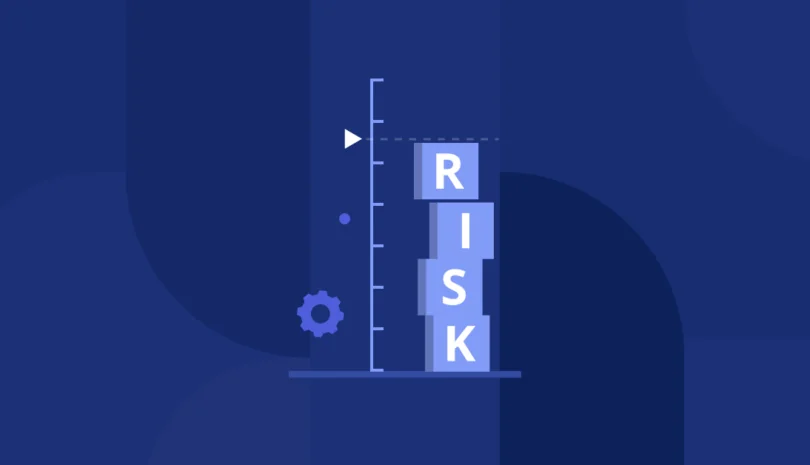Vendor risk ratings have become a critical element in third-party cybersecurity risk management, but like every tool, they are only effective when used appropriately. They can’t singlehandedly resolve every vendor-based threat to your organization. In fact, if you rely on them too much, you could end up exposing your systems to risk.
That’s why it’s crucial to understand what vendor risk ratings actually mean for your security, compliance, and business decision-making. They can give you valuable insights into vendors’ overall risk posture, but they also have their limitations. For greatest impact, ratings need to be integrated into your broader risk management strategies.
In this article, we’ll explore how vendor risk ratings work and the factors that influence them, as well as their limitations and drawbacks. You’ll also find best practices for using vendor risk ratings effectively to manage third-party risk and protect your organization.
What Are Vendor Risk Ratings?
Vendor risk ratings are numerical or categorical scores that represent the level of cybersecurity risk posed by third-party vendors. They offer a simple and streamlined way to assess potential risks, based on factors like cybersecurity practices, past data breaches and security incidents, and compliance with relevant regulations.
Overall, vendor risk ratings provide a picture of how well your vendors can protect sensitive data, maintain business continuity, and respond to potential threats. They enable you to quickly assess the potential risk of everyone in your supply chain, and make faster and more informed decisions about partnerships and business relationships.
With the help of these ratings, you can identify high-risk vendors and either decide to avoid working with them, or develop appropriate risk mitigation strategies that neutralize the risks they pose. Ratings also help you prioritize risk mitigation efforts, ensure regulatory compliance, and protect your business from disruption, data breaches, or reputational damage.
The Role of Vendor Risk Management Platforms
It’s close to impossible to calculate vendor risk ratings using manual methods alone. You need a platform like Panorays to collect and analyze data, and convert it into a coherent and comprehensive score.
Vendor risk management platforms can map every vendor in your supply chain to assess your extended attack surface. They evaluate vendors’ regulatory compliance, and continuously monitor each vendor’s security posture, delivering a more holistic view of vendor risk. Dynamic risk ratings enable you to spot the early signs of emerging threats, so you can proactively prevent them from disrupting business operations or breaching your sensitive data.
How Are Vendor Risk Ratings Calculated?
When you know the ways that vendor risk ratings are calculated, it gives you a better understanding of the meaning of those ratings, and helps you to use them more effectively.
Vendor risk ratings are based on security posture analysis which evaluates the vendor’s overall cybersecurity status, together with data from a range of sources. This information is fed into proprietary scoring algorithms to generate an overall risk score, which is then adjusted using various criteria to deliver a contextually-accurate representation of vendor risk.
Security Posture Analysis
Security posture analysis is the core of vendor risk ratings. It involves closely monitoring each vendor’s external and internal security postures, to gauge their overall resilience to cyber threats.
The risk management platform evaluates factors like open vulnerabilities which could be exploited; adherence to encryption best practices; and patch management that shows how quickly the vendor addresses known issues. These criteria help reveal existing risks and the vendor’s commitment to maintaining a secure environment.
Vendor Risk Rating Data Sources
Vendor risk ratings pull data from a range of sources for insights into potential vulnerabilities. These include:
- Public records such as breach reports and compliance filings, which reveal past incidents and regulatory adherence.
- Dark web activity monitoring to uncover sensitive data leaks, or threat actor discussions which can indicate future attacks.
- Direct scans of the vendor’s external attack surface, to identify open ports, outdated software, and other exposures that could be exploited.
Risk Scoring Models
Finally, risk management platforms use proprietary scoring algorithms to convert the security posture analysis and vendor risk data into a single vendor risk rating. They use both quantitative metrics, and contextual factors that consider specific criteria and the current risk environment. This helps ensure that the ratings reflect not just the vendor’s current risk level, but also how it aligns with your specific risk tolerance and security needs.
Key Components of Vendor Risk Ratings
Vendor risk ratings rely on a number of different components of the vendor’s security and operational history, each of which play an important role in building a reliable and comprehensive risk score. The main elements include:
- Evaluating their cybersecurity practices, including network security, data encryption, incident response, and threat intelligence;
- Assessing compliance with relevant regulations, such as GDPR, HIPAA, NIST, and DORA;
- Reviewing the vendor’s history of incidents and breaches, and how they responded to those events.
Let’s take a closer look at each of these components.
Cybersecurity Practices
Cybersecurity is a core issue for vendor risk ratings. A vendor that doesn’t have a resilient cybersecurity posture represents an enormous threat to your organization, so the vendor’s reliability in protecting their data and systems is key for any vendor risk rating.
A full evaluation of vendor cybersecurity practices should cover network security, including firewall configurations, access controls, and intrusion detection systems, and encryption for data in transit and in storage. It’s also important to assess incident response capabilities, and analyze their threat intelligence to check that they proactively monitor emerging threats.
Compliance with Regulations
Vendors that don’t adhere to industry standards can threaten your own compliance posture and expose you to fines, breaches, and reputational damage. Risk assessments need to verify that vendors comply with key industry regulations like GDPR, HIPAA, NIST, and DORA.
Compliance also shows that the vendor takes issues like data privacy, business continuity, and incident management seriously and is committed to maintaining high standards in these areas.
Historical Breaches and Incidents
The vendor’s record in dealing with past incidents and data breaches give a good indication of their vulnerability to cyber threats and how they handle cybersecurity when under pressure.
Risk management platforms look at details like the frequency, scale, and type of incidents, and the vendor’s response time, communication transparency, and corrective actions. A history of repeated and/or poorly-handled incidents indicate a vendor with high risk levels and weak security practices.
What Do Vendor Risk Ratings Mean for Your Organization?
Vendor risk ratings are an important tool for effective third-party risk management, but like every tool, they only make a difference when you put them to good use. Your security team should use vendor risk ratings to:
- Prioritize risks and allocate resources effectively
- Make informed decisions about vendor relationships
- Demonstrate due diligence and compliance with regulations and industry standards
In the following sections, we’ll examine the ways that vendor risk ratings can help your organization improve cybersecurity defenses and overall business resilience.
Risk Prioritization
Vendor risk ratings provide your security team with clear, easy-to-read insights into vendor risk levels. With this guidance, they can allocate resources towards those that pose the highest potential threats, and prioritize the most serious risks to be first in line for mitigation efforts.
Vendors that have higher risk ratings can be selected for additional scrutiny, like more frequent audits, more detailed security assessments, or extra contractual requirements for enhanced security controls. Vendor risk ratings also allow you to address vendors systematically, which reduces exposure to potential threats and enhances overall security and resilience.
Informed Decision-Making
A lot is riding on your security teams making the right call about issues like which vendors to work with and how much access to allow them to your data and systems. A reliable vendor risk rating provides a solid, data-driven understanding of each vendor’s risk profile.
This is particularly valuable during key decision points like vendor onboarding, contract renewals, or mergers and acquisitions. Risk ratings serve as a foundation for decision-makers to assess whether a vendor meets your risk tolerance and security standards, and enables you to choose partners who align with your risk management strategies and operational needs.
Vendor Risk Ratings Help Meet Compliance and Regulatory Requirements
Many regulations, including GDPR, CCPA, and NYDFS, require organizations to ensure that their third-party vendors meet specific cybersecurity standards, so as to protect sensitive data and maintain privacy. Vendor risk ratings offer a structured way to evaluate and monitor third-party cybersecurity practices for compliance with these standards.
By using vendor risk ratings, you can systematically assess each vendor’s compliance posture, and identify any security gaps or risks that may require attention. It’s a proactive approach that helps you to demonstrate due diligence in managing third-party risks, ultimately reducing the risk of regulatory fines and penalties.
Limitations of Vendor Risk Ratings
It’s important to note that while vendor risk ratings bring many benefits, they aren’t a silver bullet. Risk ratings have certain limitations to their efficacy. In fact, if they aren’t used correctly they could even increase your risk exposure.
The limitations of vendor risk ratings include a lack of context when compiling them; a time lag that means they don’t reflect real-time risks; and an over-reliance on risk ratings. It’s important to be aware of these potential drawbacks to vendor risk ratings, and to use them advisedly.
Lack of Context in Vendor Risk Ratings
Vendor risk ratings that don’t take context into account can become dangerously skewed and inaccurate. Many risk ratings are based only on external assessments without including internal security controls, which can distort the truth about vendor risk levels.
They also may not consider your specific business context, which affects your sensitivity to threats. Issues that aren’t a concern for some verticals can be very serious indeed for business in other industries.
Vendor Risk Rating Time Lag
Another problem is that vendor risk ratings can be out of date. Risk ratings that don’t reflect recent improvements or newly-emerging threats can cause you to invest in unnecessary protections or mislead you into complacency.
Today’s threat landscape is evolving rapidly, and so are vendor threat exposures. But if vendor risk rating assessments are only carried out periodically and ratings aren’t updated in real time, you might have an incorrect view of vendor risk levels.
Over-Reliance on Vendor Risk Rating Scores
Finally, there’s a chance that you could rely too much on vendor risk ratings. Even if your ratings are accurate and trustworthy, you shouldn’t depend solely on them for your security decision-making.
Unless you combine them with further context for your business and for each vendor, and manual assessments that enhance risk ratings, you may draw the wrong conclusions.
Best Practices for Using Vendor Risk Ratings Effectively
Despite the above-mentioned limitations to vendor risk ratings, they can play a powerful role in successful risk management. It’s crucial to implement them in accordance with established best practices, so as to gain the maximum benefit. These best practices include:
- Integrating vendor risk ratings in your broader risk management strategy
- Adopting continuous monitoring to keep risk ratings up to date
- Developing risk mitigation strategies for high-risk vendors
Let’s take a closer look at the most important best practices for vendor risk ratings.
Integrate with Broader Risk Management
Rather than relying solely on risk ratings, you should treat them as a single plank within a larger, comprehensive vendor risk management (VRM) strategy. For example, manual assessments like on-site audits and interviews with vendor personnel can uncover more nuanced risks than vendor risk ratings.
Ratings also need to be combined with ongoing monitoring to track any changes in risk levels over time. Additionally, you should include contractual obligations that hold vendors accountable for maintaining security standards and responding swiftly to emerging threats. Your contracts may specify SLAs like incident reporting, vulnerability scans, and adherence to regulatory standards.
Continuous Monitoring
The cyber risk environment changes rapidly, with new vulnerabilities, attack techniques, and regulatory requirements constantly appearing. Risk ratings provide a snapshot in time of the vendor’s current risk assessment. You need to update them regularly so that they reflect the evolving cybersecurity landscape.
Continuous monitoring tools help with this by providing real-time updates and notifications whenever there are significant changes to a vendor’s risk score or cybersecurity posture. This way, you can be sure that vendor risk ratings accurately reflect current conditions, and respond proactively to emerging threats and potential vulnerabilities.
Develop Risk Mitigation Strategies
Most importantly, vendor risk ratings empower your security teams to make informed choices about vendor relationships. If a vendor has a high risk rating, you don’t necessarily need to avoid working with them.
Because you have detailed information about vendor risk posture, you can develop strategies that mitigate those risks and enable you to safely include them in your supply chain. Use risk ratings to guide you towards the most effective security measures for risk mitigation, such as contractual clauses, more frequent audits, and/or limiting access to sensitive data.
The Future of Vendor Risk Ratings
Vendor risk ratings are evolving rapidly. Platforms like Panorays are integrating artificial intelligence (AI) and machine learning (ML) into their offerings to improve vendor risk ratings. For example, AI can automate data collection for Nth-party vendors, and ML analyzes the enormous datasets to deliver more accurate risk ratings.
With the help of AI, Panorays and other vendor risk ratings platforms carry out continuous monitoring, providing dynamic Risk DNA assessments that keep ratings updated in real time. Risk assessments are also more personalized when AI scoring models take your business context into account, allowing your teams to make more effective data-based decisions.
Vendor Risk Rating Solutions
Overall, vendor risk ratings provide critical insights into the cybersecurity posture of third-party vendors. With reliable and dynamic ratings, you can prioritize risks for mitigation efforts, make informed decisions about vendor relationships, and strengthen compliance with regulatory standards.
However, ratings should always remain just one element of a broader risk management strategy, kept relevant through continuous monitoring, and used to enhance risk mitigation policies. When used correctly, vendor risk ratings can bolster your cybersecurity and general business resilience, helping protect your organization from threats that could disrupt operations and/or cause data breaches.
If you haven’t already adopted vendor risk ratings, or you haven’t yet integrated them into a wider vendor risk management program, now is the time. Deploying vendor risk ratings within a balanced risk management strategy empowers you and your teams to make more informed, secure business decisions that ultimately safeguard business continuity and drive business growth.
Vendor Risk Rating FAQs
-
A vendor risk rating is a numerical or categorical score that represents the level of risk posed by each of your vendors. It’s based on a range of factors, including cybersecurity practices, historical security incidents, and regulatory compliance, to help you identify high-risk vendors, make informed decisions about vendor relationships, and develop appropriate risk mitigation strategies.
-
There are many types of vendor risks, including cybersecurity risk, regulatory compliance risks, operational risk, reputational risk, financial risk, geographic risk, and strategic risk. Cybersecurity vendor risks include data breaches, unauthorized access, service outages, financial fraud, malware infections, and supply chain attacks.
-
One example of vendor risk rating is if a financial services company evaluates a cloud storage provider, assessing factors like cybersecurity practices, regulatory compliance, historical breaches, and overall financial stability. It might give the vendor a risk rating of “medium” or 3 out of 5, indicating that the vendor has solid security measures but also notable vulnerabilities like a minor data breach or non-compliance with some relevant certifications.



